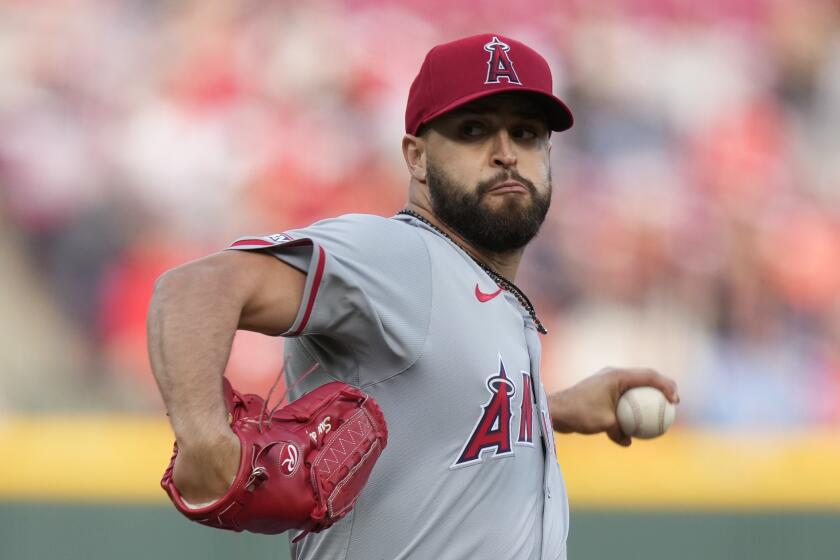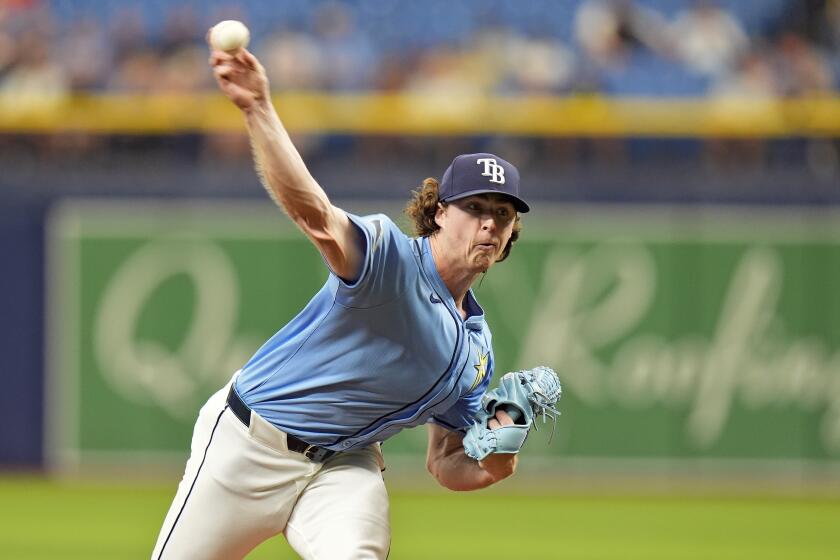BEAT ‘EM, JOIN ‘EM
TEMPE, Ariz. -- Rare is the topic that is off limits in a spring-training clubhouse, especially if it can spark some good-natured ribbing, playful banter or a prank.
But there is one subject pitcher Jon Garland and his new Angels teammates haven’t touched: the four-hitter Garland threw against the Angels in Game 3 of the 2005 American League Championship Series, leading the Chicago White Sox to a pivotal 5-2 win.
“Nobody has said anything about it,” said Garland, a 28-year-old right-hander who was acquired for shortstop Orlando Cabrera in November. “And I’m not going to say anything about it.”
Garland’s complete-game triumph -- and that bitter Angels loss -- might be taboo, but it’s one of the primary reasons Garland is here, and why the Angels gave up a reliable defender and productive No. 2 hitter to acquire the 6-foot-6 sinkerball specialist.
Sure, the Angels love that Garland was an 18-game winner in 2005 and 2006, that he has at least 10 wins, 30 starts and 200 innings pitched for four consecutive seasons, and that his 46 victories the last three seasons are tied for sixth-most in the major leagues.
But the Angels don’t want to just reach October, they want to play deep into October, and Garland showed in 2005 that he is the kind of pitcher who can help take them there.
The ALCS was tied, 1-1, when Garland outpitched John Lackey in Anaheim, the second of four consecutive wins that propelled the White Sox into the World Series.
Garland started Game 3 of the World Series against Houston, giving up two earned runs in seven innings of a 7-5, 14-inning win. The White Sox completed a four-game sweep the following night to win their first World Series title since 1917.
“That was big,” Garland said of his first postseason experience. “I was known as a .500 pitcher who went deep into games and gave the team a chance to win, but that let me know I could pitch in the playoffs, that a big game doesn’t bother me.
“For a team that wants to be in the playoffs every year and go to the World Series, they know they have someone they can depend on. From the media and fans, that’s what you hear about, that this guy’s a big-game pitcher. . . . You almost have to prove yourself.”
The Angels have always liked Garland -- they nearly acquired him for Darin Erstad at the 2001 winter meetings, a deal that was nixed by then-Disney executive Paul Pressler.
The 2005 postseason enhanced Garland’s resume, and the Angels weren’t scared off by his 10-13 record in 2007.
Garland, entering the final year of a three-year contract that will pay him $12 million this season, had a respectable 4.23 earned-run average, threw 208 1/3 innings and had 21 quality starts in which he went at least six innings and gave up three earned runs or fewer.
He just wasn’t pitching for a quality team -- the injury-plagued White Sox were 72-90, finishing fourth in the AL Central.
“His numbers were much better internally than his win-loss record indicates, and with more support he has the ability to win 20 games,” Angels Manager Mike Scioscia said.
“Not only is he a strike thrower, he throws good command strikes on tough counts, he’s shown the ability to make pitches in tough situations, and if you make the plays behind him he’s going to get out of jams.”
Infield defense is important to Garland, because even going back to his days at Granada Hills Kennedy High, he has never been a strikeout pitcher; he has natural sink on his two-seam fastball and relies heavily on ground-ball outs.
The left side of the infield could be a problem. Third baseman Chone Figgins is not a Gold Glove defender, and Erick Aybar and Maicer Izturis are not proven big league shortstops.
But that could be offset by the move from U.S. Cellular Field -- a hitter’s park -- to Angel Stadium, where balls that are home runs at so many other fields often die on the warning track.
“Pitching in U.S. Cellular, the opportunity for the ball to fly out of the park at any given time was . . . you can make the best pitch in the world and a guy could put it out on a bad swing,” said Garland, who gave up an average of 26 homers a season the last five years.
“In Anaheim, with the heavier air, definitely a bigger field, you’re going to go right after guys. Especially for me and with the outfield that is behind me now, it’s going to be, ‘Here it is, hit it, see what you can do with it.’ ”
Garland’s ability to get early-count outs and pitch deep into games should ease the burden on relievers such as Scot Shields and Justin Speier.
“It’s going to save our bullets,” Shields said.
And with Kelvim Escobar sidelined until at least May because of a shoulder injury, Scioscia needs starters he can rely on.
Garland, who could pitch the season opener if Lackey’s sore elbow isn’t ready on time, hasn’t missed a start since 2000, when he took a Fred McGriff line drive off the elbow.
“He brings stability, a lot of innings -- he has a great track record,” Lackey said of Garland. “He’s always even-keeled. He doesn’t show a lot of emotion, good or bad.”
In that regard, Garland might be the Garret Anderson of pitchers, a guy with a poker face that is tough to read.
Just don’t misread him.
“A note out to all the people -- if you see me on the mound and don’t think I’m trying or don’t like my body mannerisms, believe me, the intensity is there,” said Garland, who went to the same high school as Anderson, but in different years.
“I’m competing, and I’m out there to win a game. It’s just my personality. I’m a very quiet guy. Not super shy -- if you get to know me, I’ll open up a little bit. But I like to go about my business and conduct myself in a professional way.”
--
More to Read
Go beyond the scoreboard
Get the latest on L.A.'s teams in the daily Sports Report newsletter.
You may occasionally receive promotional content from the Los Angeles Times.





